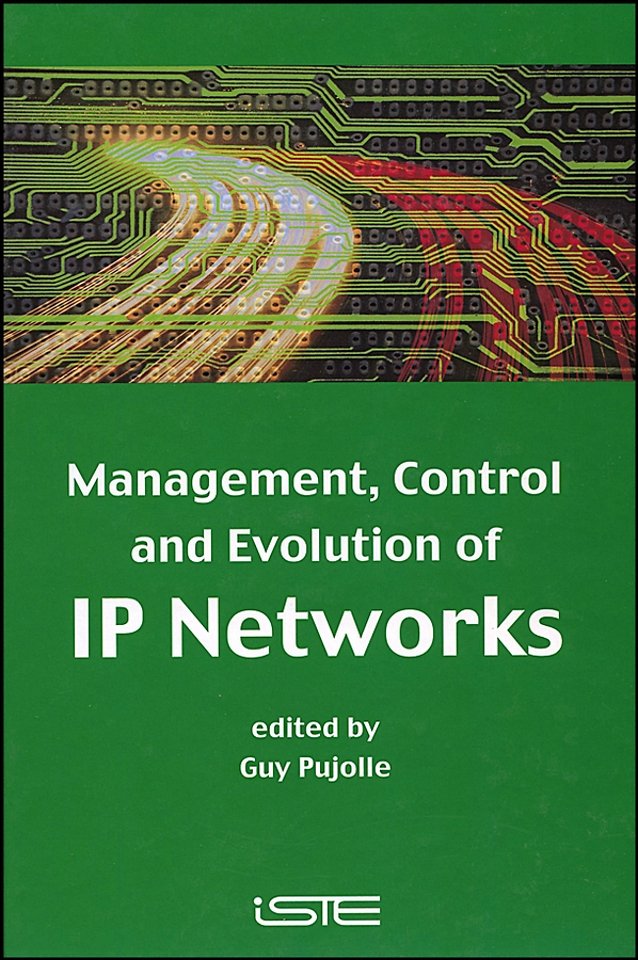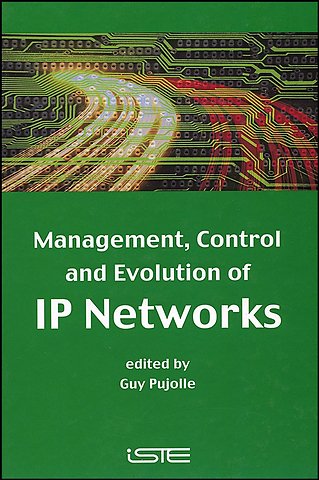Samenvatting
Internet Protocol (IP) networks have, for a number of years, provided the basis for modern communication channels. However, the control and management of these networks needs to be extended so that the required Quality of Service can be achieved.
Information about new generations of IP networks is given, covering the future of pervasive networks (that is, networks that arealways present), Wi–Fi, the control of mobility and improved Quality of Service, sensor networks, inter–vehicle communication and optical networks.
Specificaties
Inhoudsopgave
<p>Chapter 1. Introduction 3<br /> Guy PUJOLLE</p>
<p>1.1. Introduction 3</p>
<p>1.2. Signaling 4</p>
<p>1.3. Flow control and management techniques 7</p>
<p>1.4. Policy–based management 14</p>
<p>1.5. Security 15</p>
<p>1.6. Mobile network control 18</p>
<p>1.7. Optical network control 19</p>
<p>1.8. Conclusion 20</p>
<p>1.9. Bibliography 20</p>
<p>Chapter 2. Quality of Service: The Basics 23<br /> Benoît CAMPEDEL</p>
<p>2.1. Introduction to Quality of Service 23</p>
<p>2.2. Network parameters 27</p>
<p>2.3. Overview of the basic mechanisms on IP 36</p>
<p>2.4. Overview 47</p>
<p>Chapter 3. Quality of Service: Mechanisms and Protocols 49<br /> Stéphane LOHIER</p>
<p>3.1. QoS and IP 49</p>
<p>3.2. IntServ (RSVP) model 54</p>
<p>3.3. The DiffServ model 64</p>
<p>3.4. MPLS architecture 71</p>
<p>3.5. QoS at level 2 75</p>
<p>Chapter 4. DiffServ: Differentiated Quality of Service 81<br /> Idir FODIL</p>
<p>4.1. Introduction 81</p>
<p>4.2. Principles of DiffServ 82</p>
<p>4.3. Structure 83</p>
<p>4.4. DiffServ in edge routers 84</p>
<p>4.5. Conclusion 88</p>
<p>4.6. Bibliography 88</p>
<p>Chapter 5. Quality of Service in Wi–Fi 91<br /> Yacine GHAMRI–DOUDANE, Anelise MUNARETTO and Hakima CHAOUCHI</p>
<p>5.1. Introduction 91</p>
<p>5.2. Packets transmission with CSMA/CA access method 92</p>
<p>5.3. MAC level QoS in IEEE 802.11 96</p>
<p>5.4. Summary and conclusion 108</p>
<p>5.5. Bibliography 109</p>
<p>Chapter 6. Quality of Service: Policy–based Management 111<br /> Thi Mai Trang NGUYEN</p>
<p>6.1. Introduction to policy–based management in IP networks 111</p>
<p>6.2. Architecture and protocols for policy–based management 113</p>
<p>6.3. The COPS protocol 114</p>
<p>6.4. COPS–RSVP 117</p>
<p>6.5. COPS–PR 119</p>
<p>6.6. SNMP 123</p>
<p>6.7. Conclusion 124</p>
<p>6.8. Bibliography 124</p>
<p>Chapter 7. Inter–domain Quality of Service 127<br /> Mauro FONSECA</p>
<p>7.1. Introduction 127</p>
<p>7.2. Goal 128</p>
<p>7.3. Motivations for the use of mobile agents to offer inter–domain QoS 131</p>
<p>7.4. Negotiation of inter–domain QoS 133</p>
<p>7.5. An architecture for inter–domain negotiation 135</p>
<p>7.6. Conclusion 147</p>
<p>7.7. Bibliography 148</p>
<p>Part 2. The Evolution of IP Networks 151</p>
<p>Chapter 8. An Introduction to the Evolution in the World of IP 153<br /> Guy PUJOLLE</p>
<p>8.1. Introduction 153</p>
<p>8.2. Great evolutions 154</p>
<p>8.3. Quality of Service 156</p>
<p>8.4. IP mobility 157</p>
<p>8.5. IP multicast 162</p>
<p>8.6. VPN IP 164</p>
<p>8.7. Filtering 168</p>
<p>8.8. Intelligent IP networks 170</p>
<p>8.9. Conclusion 171</p>
<p>8.10. Bibliography 171</p>
<p>Chapter 9. IPv6, the New Internet Generation 175<br /> Idir FODIL</p>
<p>9.1. Introduction 175</p>
<p>9.2. IPv6 characteristics 176</p>
<p>9.3. IPv6 packet header 177</p>
<p>9.4. IPv6 addressing 178</p>
<p>9.5. Transition from IPv4 Internet to IPv6 Internet 181</p>
<p>Chapter 10. Addressing in IP Networks 193<br /> Julien ROTROU and Julien RIDOUX</p>
<p>10.1. Introduction 193</p>
<p>10.2. IPv4 addressing 194</p>
<p>10.3. The future version of the IP protocol: IPv6 203</p>
<p>10.4. Conclusion 215</p>
<p>10.5. Bibliography 216</p>
<p>Chapter 11. SLA Driven Network Management 219<br /> Issam AIB and Belkacem DAHEB</p>
<p>11.1. Introduction 219</p>
<p>11.2. Requirements for service driven management 219</p>
<p>11.3. The SLA 221</p>
<p>11.4. Specification of level of service (SLS) 223</p>
<p>11.5. Service contract chains 226</p>
<p>11.6. SLA types 227</p>
<p>11.7. SLA management (SLM) 228</p>
<p>11.8. SLA modeling and representation 231</p>
<p>11.9. Research projects and activities 233</p>
<p>11.10. Conclusion 244</p>
<p>11.11. Abbreviations and acronyms 244</p>
<p>11.12. Bibliography 245</p>
<p>Chapter 12. New Approaches for the Management and Control of IP Networks 247<br /> Yacine GHAMRI–DOUDANE</p>
<p>12.1. Introduction 247</p>
<p>12.2. Network management policies 248</p>
<p>12.3. Policy–based management framework 250</p>
<p>12.4. COPS protocol 254</p>
<p>12.5. Policy domains 257</p>
<p>12.6. Information modeling 260</p>
<p>12.7. Conclusion 263</p>
<p>12.8. Bibliography 264</p>
<p>Chapter 13. Internet Security 267<br /> Vedat YILMAZ</p>
<p>13.1. Introduction 267</p>
<p>13.2. Elements of security 267</p>
<p>13.3. User data security 270</p>
<p>13.4. Internet infrastructure security 277</p>
<p>13.5. Internet access infrastructure security 283</p>
<p>13.6. Summary and conclusion 289</p>
<p>13.7. Bibliography 290</p>
<p>Chapter 14. Security Protocols for the Internet 293<br /> Idir FODIL</p>
<p>14.1. Introduction 293</p>
<p>14.2. IPSec 294</p>
<p>14.3. IEEE 802.1x 300</p>
<p>14.4. Bibliography 304</p>
<p>Chapter 15. Secured Infrastructure for Ambient Virtual Offices 307<br /> Laurent CIARLETTA and Abderrahim BENSLIMANE</p>
<p>15.1. Introduction to ambient Internet and to its needs in terms of security 307</p>
<p>15.2. Virtual Private Smart Spaces (VPSS) 309</p>
<p>15.3. An infrastructure secured by ambient virtual offices 315</p>
<p>15.4. Conclusion and perspectives 324</p>
<p>15.5. Bibliography 326</p>
<p>Chapter 16. Smart Card Security 329<br /> Vincent GUYOT</p>
<p>16.1. Introduction 329</p>
<p>16.2. History 330</p>
<p>16.3. Different parts of a smart card 330</p>
<p>16.4. Smart card communication 333</p>
<p>16.5. A secure component 339</p>
<p>16.6. Smart card alternatives. 340</p>
<p>16.7. Smart card security advantages 341</p>
<p>16.8. Network security 347</p>
<p>16.9. Conclusion 349</p>
<p>16.10. Bibliography 349</p>
<p>Chapter 17. Video Adaptation on the Internet 353<br /> Nadjib ACHIR</p>
<p>17.1. Introduction 353</p>
<p>17.2. Error control 355</p>
<p>17.3. Point–to–point congestion and flow control 359</p>
<p>17.4. Multicast congestion and flow control 362</p>
<p>17.5. An example of video adaptation: multi–object video transmission 367</p>
<p>17.6. Conclusion 377</p>
<p>17.7. Bibliography 378</p>
<p>Chapter 18. Voice over IP 383<br /> Guy PUJOLLE</p>
<p>18.1. Introduction 383</p>
<p>18.2. Telephonic application in an IP context 384</p>
<p>18.3. Audio coders 385</p>
<p>18.4. Telephony over IP 387</p>
<p>18.5. Signaling protocols 389</p>
<p>18.6. QoS 400</p>
<p>18.7. Corporate IP telephony networks 412</p>
<p>18.8. Implementation of telephony over IP 413</p>
<p>18.9. Telephonic IP applications for the general public 414</p>
<p>18.10. Telephony–data integration 414</p>
<p>18.11. Conclusion 415</p>
<p>18.12. Bibliography 415</p>
<p>Chapter 19. Wireless Voice over IP 417<br /> Laurent OUAKIL</p>
<p>19.1. Introduction 417</p>
<p>19.2. Wireless VoIP problems 418</p>
<p>19.3. Voice management indications and designs 421</p>
<p>19.4. Adapting wireless QoS for voice 428</p>
<p>19.5. Conclusion 438</p>
<p>19.6. Bibliography 439</p>
<p>Part 3. The Next Generation of IP Networks 441</p>
<p>Chapter 20. Pervasive Networks 443<br /> Sidi–Mohammed SENOUCI</p>
<p>20.1. Introduction 443</p>
<p>20.2. Ambient intelligence 444</p>
<p>20.3. Ambient networks 447</p>
<p>20.4. Conclusion 465</p>
<p>20.5. Bibliography 465</p>
<p>Chapter 21. Wi–Fi/IEEE 802.11 469<br /> Denis BEAUTIER</p>
<p>21.1. Introduction. 469</p>
<p>21.2. Technology 472</p>
<p>21.3. Amendments, progress and characteristics 488</p>
<p>21.4. Conclusion 494</p>
<p>21.5. Appendices 497</p>
<p>21.6. Bibliography 499</p>
<p>Chapter 22. Mobility and Quality of Service 501<br /> Hakima CHAOUCHI</p>
<p>22.1. Introduction. 501</p>
<p>22.2. Summary of QoS and mobility architectures 502</p>
<p>22.3. Mobility architectures 509</p>
<p>22.4. Impact of mobility on QoS 516</p>
<p>22.5. Interaction architectures between QoS and mobility 519</p>
<p>22.6. Band interactions 519</p>
<p>22.7. Interaction with band signaling: INSIGNIA 525</p>
<p>22.8. Other communities 526</p>
<p>22.9. Conclusion 527</p>
<p>22.10. Bibliography 528</p>
<p>Chapter 23. Sensor Networks 531<br /> Paulo GONÇALVES</p>
<p>23.1. Introduction 531</p>
<p>23.2. Definitions 533</p>
<p>23.3. Transmission medium 535</p>
<p>23.4. Platforms 536</p>
<p>23.5. Energy consumption 539</p>
<p>23.6. Power supply 540</p>
<p>23.7. Evaluation metrics 543</p>
<p>23.8. Network protocols 544</p>
<p>23.9. Auto–organization 546</p>
<p>23.10. Applications 547</p>
<p>23.11. IEEE 802.15.4 standard or ZigBee 549</p>
<p>23.12. Production cost 549</p>
<p>23.13. Conclusion 549</p>
<p>23.14. Bibliography 549</p>
<p>Chapter 24. Mobile Ad Hoc Networks: Inter–vehicle Geocast 553<br /> Abderrahim BENSLIMANE</p>
<p>24.1. Introduction 553</p>
<p>24.2. Mobile ad hoc networks 555</p>
<p>24.3. Communication in intelligent transport 557</p>
<p>24.4. Inter–vehicle geocast 559</p>
<p>24.5. Performance evaluation 565</p>
<p>24.6. Conclusion 570</p>
<p>24.7. Bibliography 571</p>
<p>24.8. Appendix 573</p>
<p>Chapter 25. Pervasive Networks: Today and Tomorrow 575<br /> Guy PUJOLLE</p>
<p>25.1. Introduction 575</p>
<p>25.2. Networks of the pervasive Internet 576</p>
<p>25.3. QoS and security 586</p>
<p>25.4. Services 587</p>
<p>25.5. Bibliography 590</p>
<p>Chapter 26. Optical Networks 591<br /> Nizar BOUABDALLAH</p>
<p>26.1. Introduction 591</p>
<p>26.2. History 592</p>
<p>26.3. Evolution of optical networks 594</p>
<p>26.4. Structure of an optical transmission system 596</p>
<p>26.5. Multiplexing techniques 598</p>
<p>26.6. Second generation optical networks 600</p>
<p>26.7. Wavelength switching optical networks 601</p>
<p>26.8. Distribution by optical fiber 604</p>
<p>26.9. Conclusion 609</p>
<p>26.10. Bibliography 609</p>
<p>Chapter 27. GMPLS–enabled Optical Networks 611<br /> Wissam FAWAZ and Belkacem DAHEB</p>
<p>27.1. Introduction 611</p>
<p>27.2. Label switching (MPLS) 612</p>
<p>27.3. Evolution of IP/MPLS signaling for optical WDM networks 622</p>
<p>27.4. Conclusion 636</p>
<p>27.5. Bibliography 636</p>
<p>List of Authors 637</p>
<p>Index 641</p>

